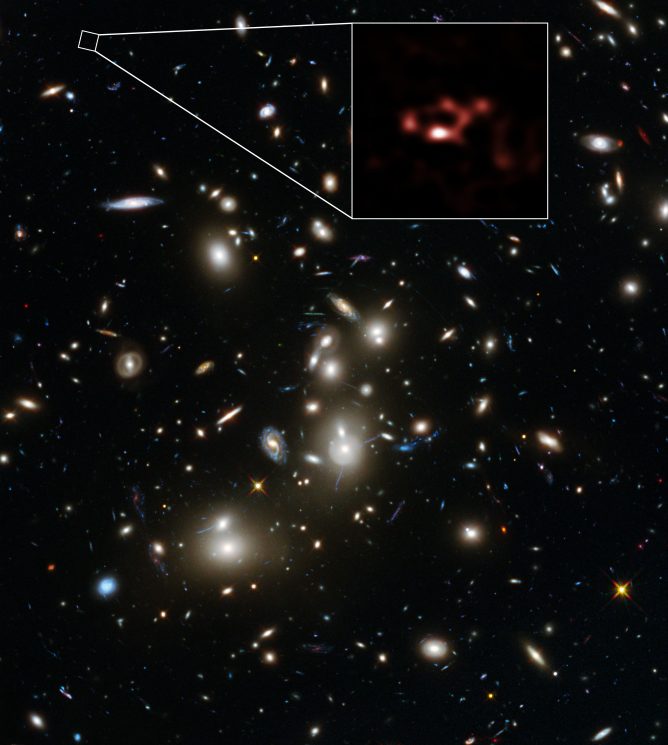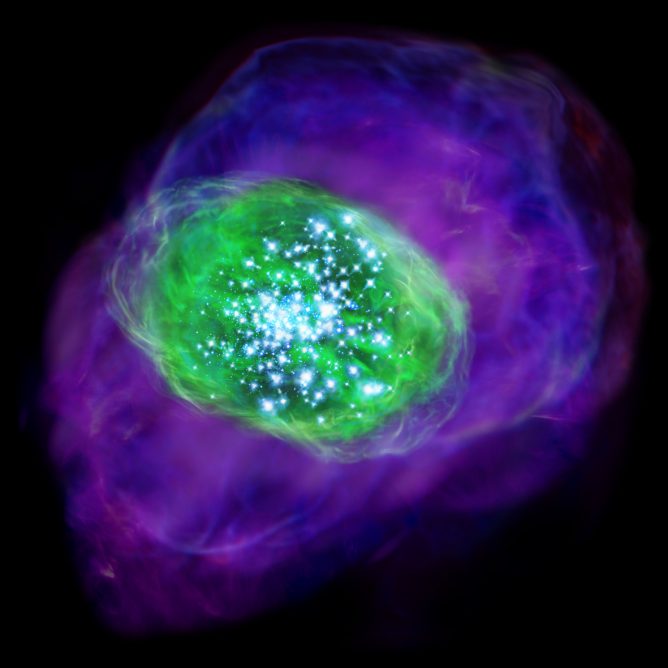Combining the capabilities of two powerful telescopes, the Atacama Large Millimeter/submillimeter Array (ALMA) and Hubble Space Telescope, astronomers have explored the nature of a mysterious huge object called “Himiko” in the early universe. The observations reveal that three primitive stellar clumps are about to be merged and forming a larger object. The observations provide an important insight of the earliest phase of galaxy formation at a time termed “Cosmic Dawn” when the universe was first bathed in starlight.
Himiko is a giant blob of hot gas, first discovered by the Subaru Telescope. This object is seen when the universe was only 800 million years old, corresponding to 6% of its present age. The giant blob is named after a legendary mysterious queen in ancient Japan, because this object is a remarkable object found early in the history of the universe in a Japanese Subaru field. The size of Himiko is 55,000 light years, about 10 times larger than typical galaxies at the same epoch. Infrared observations with Spitzer Space Telescope show that Himiko is as massive as several tens of billions of suns. These features indicate that Himiko is a distinctive object in the process of galaxy formation. On the other hand, the energy source of the giant glowing hot gas was veiled in mystery.
An international research team led by Dr. Masami Ouchi, an associate professor at the Institute for Cosmic Ray Research, The University of Tokyo, conducted intensive observations of Himiko with ALMA and the Hubble Space Telescope. These two telescopes can accomplish observations with uniquely high sensitivities and spatial resolutions in radio or near infrared wavelength.. “We have performed the deepest and most sensitive observations of Himiko with an angular resolution unmatched by earlier work. These observations have successfully addressed the puzzling nature of Himiko, but brought some new surprises!” explains Ouchi.
The Hubble images (Figure 1) reveal three stellar clumps aligned over 20 thousand light years. Each clump has brightness comparable to a typical luminous galaxy at the epoch of Himiko, when the Universe was only 800 million years old. The gigantic hydrogen cloud (or space blob) engulfs the three clumps. No single bright core is found, ruling out the possibility that Himiko is powered by a supermassive black hole. By combining the Hubble and Spitzer Space Telescope data, the astronomers reveal intense star formation in Himiko. Matthew Ashby, a team member at Harvard-Smithsonian Center for Astrophysics, said “We find Himiko is converting gas into stars at a rate of about a hundred solar masses per year, several times more intensely than any known object at this epoch. This intense star production rate is probably sufficient to heat the vast space blob.”
The most astonishing find, however, is that the ALMA data show no signal of carbon gas which is used as the index of star formation nor radiation from dust clouds within the system heated by young stars. The radio intensity of carbon gas emission is more than 30 times weaker than present-day galaxies with comparable star formation activities. Given the sensitivity of ALMA, this is truly remarkable.
In the first few minutes after the Big Bang, light elements, e.g. hydrogen and helium, are created. On the other hand, “heavy” elements such as carbon and oxygen are synthesized by nuclear fusion reactions in stars. “Himiko reveals no radio emission from either the solid or gaseous state of heavy elements.” remarked Kotaro Kohno, a member of the team. “Star formation and associated supernova explosions normally create dust clouds composed of grains of carbon, oxygen, silicon and other elements. This dust is heated by ultra-violet radiation from massive newborn stars and the warm dust then re-radiates at radio wavelengths. Such radiation is not detected in Himiko. Even more surprising, we detect no emission from gaseous carbon”.
As a result, the astronomers speculate that Himiko could be composed of primordial gas, a mixture of the light elements of hydrogen and helium created in the Big Bang. If correct, this would be a landmark discovery signaling the detection of a primordial galaxy seen during its formation.
Richard Ellis, a team member at the California Institute of Technology said with humor “Astronomers are usually excited when a signal from an object is detected. But, in this case, it’s the absence of a signal from heavy elements that is the most exciting result!”
Figure 1. A composite color image of Himiko based on Hubble, Subaru, and Spitzer data. The left panel shows the field around Himiko as viewed by Hubble: the position of Himiko is marked with a square. The right panels show close up views of the Hubble image (top) and a combination of Hubble, Subaru, and Spitzer images (bottom). In the Hubble image, infrared light captured by Hubble’s Wide Field Camera 3 at 0.98, 1.25, and 1.6 microns are
represented by blue, green, and red, respectively. In the Hubble/Subaru/Spitzer image, the combination of three Hubble infrared bands is green, while Lyman alpha emission captured by Subaru Suprime-Cam and infrared 3.6 micron taken by Spitzer Infrared Array Camera are presented with blue and red, respectively.
Credit: NASA, ESA, The University of Tokyo (M. Ouchi)
Click to Enlarge (JPEG/ 382KB)
Figure 2. Artist’s rendition of Himiko that is based on the results from the observations of ALMA and Hubble Space Telescope. Himiko is mainly composed of clean primordial gas with a little amount of heavy elements.
Credit: NAOJ
Click to Enlarge (JPEG/ 4.9 MB)
More Information
The research findings are presented in the article “An Intensely Star-Forming Galaxy at z~7 with Low Dust and Metal Content Revealed by Deep ALMA and HST Observations” published in the Astrophysical Journal, Volume 778 of December 1, 2013.
The research team members are: Masami Ouchi (The University of Tokyo), Richard Ellis (California Institute of Technology), Yoshiaki Ono (The University of Tokyo), Koichiro Nakanishi (NAOJ/Joint ALMA Observatory/Sokendai), Kotaro Kohno (The University of Tokyo), Rieko Momose (The University of Tokyo), Yasutaka Kurono (Joint ALMA Observatory), M. L. N. Ashby (Harvard-Smithsonian Center for Astrophysics), Kazuhiro Shimasaku (The University of Tokyo), S. P. Willner (Harvard-Smithsonian Center for Astrophysics), G. G. Fazio (Harvard-Smithsonian Center for Astrophysics), Yoichi Tamura (The University of Tokyo)、Daisuke Iono (NAOJ)
The work was funded by the NASA through a grant from the Space Telescope Science Institute, which is operated by the Association of Universities for Research in Astronomy, Inc., under NASA contract NAS 5-26555. The researchers were supported by World Premier International Research Center Initiative (WPI Initiative), MEXT, Japan, and KAKENHI (23244025) Grant-in-Aid for Scientific Research (A) through Japan Society for the Promotion of Science (JSPS). This work makes use of the following ALMA data: ADS/JAO.ALMA#2011.0.00115.S. This work is based in part on observations made with the Spitzer Space Telescope, which is operated by the Jet Propulsion Laboratory, California Institute of Technology under a contract with NASA. Support for this work was provided by NASA through an award issued by JPL/Caltech.










